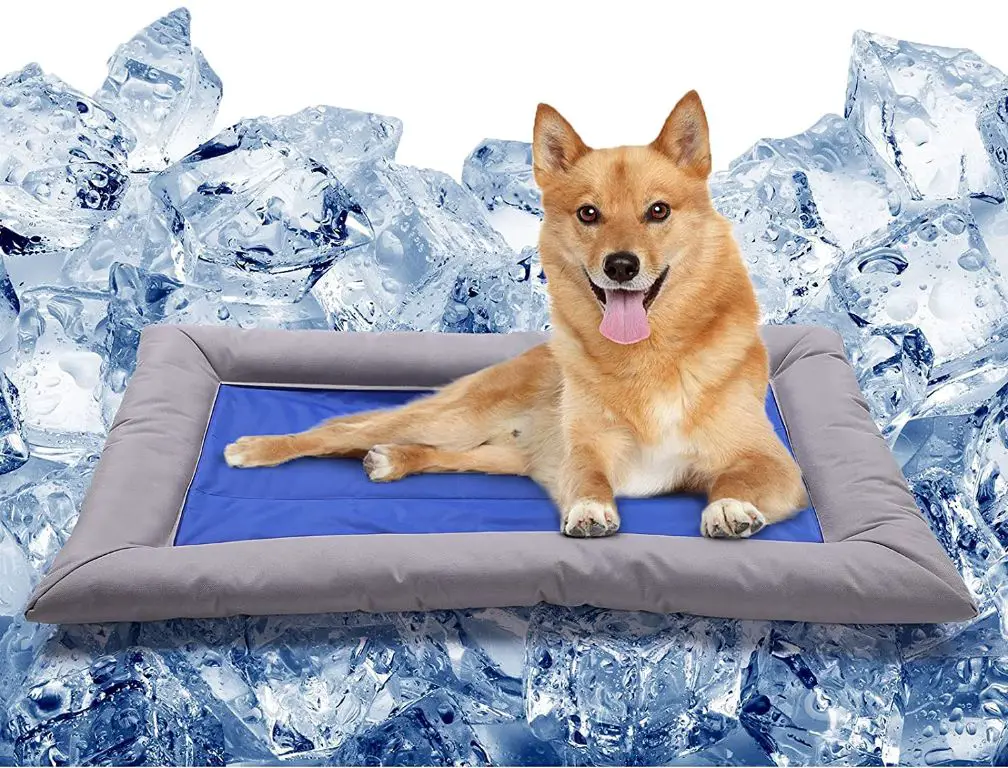With summer temperatures on the rise, pet owners are looking for ways to keep their dogs cool and comfortable. One popular solution is gel-infused cooling beds. But do these beds actually lower a dog’s body temperature, or are they just a gimmick?
Page Contents
How do cooling gel dog beds work?
Cooling gel dog beds contain a viscoelastic gel that absorbs and dissipates heat. The gel is designed to feel cool to the touch. When a dog lays on the bed, their body heat activates the cooling gel. The gel absorbs the heat and distributes it evenly throughout the bed, preventing hot spots.
As the gel absorbs heat, it also draws heat away from the dog’s body through conduction. This creates a chilling effect that helps lower the dog’s surface temperature and keeps them comfortable. The gel needs sufficient pressure and time to fully absorb and dissipate heat, so it works best when the dog is resting or sleeping on the bed.
What are the benefits of cooling gel dog beds?
There are several potential benefits to using a cooling gel dog bed:
- Lower surface temperature – The cooling gel can lower a dog’s surface temperature, helping prevent overheating.
- Comfort – The chilled gel creates a comfortable place for dogs to rest, especially on hot days.
- Cushioning – Gel beds provide cushioning and orthopedic support.
- Portability – Many gel beds are lightweight and foldable for use in crates, cars, etc.
- No electricity required – Gel beds work through conduction, no power needed.
For senior dogs or dogs with medical conditions like heart disease, cooling beds may also help prevent heat-related health risks like dehydration and elevated body temperature.
Are there any concerns with gel dog beds?
While gel beds have benefits, there are some potential drawbacks to consider:
- Cost – Gel beds tend to be more expensive than other types of beds.
- Durability – The gel may lose effectiveness over time.
- Chew resistance – Gel and cover material may not withstand aggressive chewers.
- Mess – Punctured beds will leak gel.
- Indoor use only – Beds aren’t designed to withstand outdoor weather.
It’s also important to note that gel beds provide a chilling effect at the surface only. They do not lower a dog’s core body temperature. Caution should be used with dogs who have trouble regulating temperature, like very old, very young, or sick dogs.
What do studies say about cooling gel dog beds?
Unfortunately there is limited scientific research on the effectiveness of gel dog beds at lowering body temperature and preventing overheating. However, a few small studies provide some initial insights:
| Study | Methods | Key Findings |
|---|---|---|
| Sottiaux (2006) | Measured surface and rectal temperatures of 5 dogs on gel and non-gel beds in climate-controlled room. | Gel beds reduced mean surface temperature by 3°F compared to non-gel beds. No difference in rectal temperatures detected. |
| White et al. (2018) | 8 dogs in climate controlled kennel monitored during daytime rest on gel and non-gel beds. | Gel beds decreased mean abdominal temperature by 1.6°F. But effect only lasted around 20 minutes. |
| Davis et al. (2021) | 10 dogs exposed to high temperatures in climate chamber. Measured rectal temps on gel and non-gel beds. | No significant difference detected in rectal temperatures between bed types. |
While more research is still needed, these initial studies suggest gel dog beds may provide a slight cooling effect on a dog’s skin and possibly abdominal temperatures. However, the effect appears relatively small and temporary. More significant cooling results are unlikely without other interventions like water, shade, and air conditioning.
Tips for keeping dogs cool in summer
While gel beds may provide some temperature relief, pet owners shouldn’t rely on them as the sole solution for keeping dogs cool. Here are some other tips for preventing overheating:
- Provide shade – Access to shade limits sun exposure and heat absorption.
- Ensure fresh water – Keep multiple bowls of cool, fresh water available.
- Limit exercise in heat – Take walks in cooler morning/evening hours.
- Watch time outdoors – Limit time outside during peak heat hours.
- Use cooling vests/bands – Special dog cooling products help remove body heat.
- Provide AC access – Ensure dogs can access air-conditioned spaces.
- Watch for signs of overheating – Excessive panting, drooling, weakness.
- Brush frequently – Keeps coat loose to allow airflow to skin.
Choosing the best cooling gel dog bed
If you do choose to try a cooling gel dog bed, be selective in your purchase:
- Choose a reputable brand with excellent reviews.
- Select the proper size bed for your dog.
- Make sure the gel is non-toxic if punctured.
- Look for durable, chew-resistant outer covers.
- Consider your dog’s needs – senior, orthopedic, anxiety, etc.
- Determine if easy cleaning is necessary for accidents.
Also, look for beds with gels designed to retain cooling properties for longer periods of time or with replaceable gel inserts for improved longevity.
Top rated cooling gel dog beds
Some top rated cooling gel dog beds include:
- K&H Pet Products Cool Bed III.
- Furhaven Chillz Memory Foam Orthopedic Dog Bed.
- The Green Pet Shop Cooling Gel Memory Foam Bed.
- Petsure Comfort Dog Cooling Bed Mat.
- Friends Forever Orthopedic Dog Bed.
Conclusion
Cooling gel dog beds can provide some surface temperature relief, especially when combined with other cooling techniques. However, their ability to lower core body temperature appears limited. These beds shouldn’t replace essential preventative measures like access to shade, water, reduced outdoor time, and climate controlled spaces. With proper expectations and precautions, gel beds can be one element in keeping dogs safe and comfortable in summer heat. But their convenience shouldn’t lead to over-reliance or neglect of a dog’s basic temperature regulation needs.
